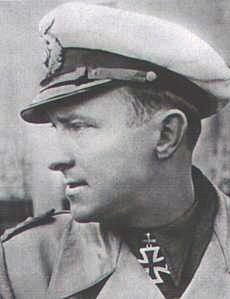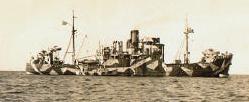
A naval mine is a self-contained explosive device placed in water to damage or destroy surface ships or submarines. Unlike depth charges, mines are deposited and left to wait until they are triggered by the approach of, or contact with, any vessel or a particular vessel type, akin to anti-infantry vs. anti-vehicle mines. Naval mines can be used offensively, to hamper enemy shipping movements or lock vessels into a harbour; or defensively, to protect friendly vessels and create "safe" zones. Mines allow the minelaying force commander to concentrate warships or defensive assets in mine-free areas giving the adversary three choices: undertake an expensive and time-consuming minesweeping effort, accept the casualties of challenging the minefield, or use the unmined waters where the greatest concentration of enemy firepower will be encountered.

Admiral Sir Harold Martin Burrough was a senior Royal Navy officer and Assistant Chief of Naval Staff to the Royal Navy during World War II.

HMS Bangor was a Bangor-class minesweeper of the Royal Navy that served during the Second World War. She was built at the Harland and Wolff shipyard in Govan, Scotland. Bangor was the lead vessel of her class and one of the diesel-engined versions. She was ordered on 12 July 1939, laid down on 19 September 1939, launched on 23 May 1940, and commissioned on 7 November 1940.

HNoMS Otra was an Otra-class minesweeper built in 1939 for the Royal Norwegian Navy. Captured by the Germans during the 1940 invasion of Norway and renamed Togo, she was returned to the Norwegians in 1946. Otra remained in service until being sold for scrapping in 1963.

Robert Karl Friedrich Gysae was a German U-boat commander in the Kriegsmarine during World War II. He was a recipient of the Knight's Cross of the Iron Cross with Oak Leaves of Nazi Germany. Gysae commanded U-98 and U-177, being credited with sinking twenty-five ships on eight patrols, for a total of 146,815 gross register tons (GRT) of Allied shipping.

The R boats were a group of small naval vessels built as minesweepers for the Kriegsmarine before and during the Second World War. They were used for several purposes during the war, and were also used post-war by the German Mine Sweeping Administration for clearing naval mines.

The M class were the standard minesweeper of Nazi Germany's Kriegsmarine during World War II. The vessels were the primary force in Germany's harbor defense command and were organized administratively into minesweeper flotillas.
Otto Adalbert Schnee was a Korvettenkapitän with Nazi Germany's Kriegsmarine during World War II. He commanded the submarines U-6, U-60, U-121, U-201 and U-2511, sinking twenty-one merchant ships on twelve patrols, for a total of 90,847 gross register tons (GRT) of Allied shipping, and received the Knight's Cross with Oak Leaves.

Adalbert von Blanc was a German naval officer during World War II and later an admiral in the West German Navy. During World War II he was awarded the Knight's Cross of the Iron Cross and served as 1st Officer on the auxiliary cruiser Orion.

The German Mine Sweeping Administration (GMSA) was an organisation formed by the Allies from former crews and vessels of the Nazi Germany's Kriegsmarine for the purpose of mine sweeping after the Second World War, predominantly in the North Sea and Baltic Sea, which existed from June 1945 to January 1948.

A Sperrbrecher, was a German auxiliary ship of the First World War and the Second World War that served as a type of minesweeper, steaming ahead of other vessels through minefields and detonating them with their reinforced hull. Also used as anti-aircraft ships, the Sperrbrecher suffered heavy losses in the war.

HMS Vesper was a V-class destroyer of the British Royal Navy that saw service in World War I and World War II.

Minesweeper flotillas of the Kriegsmarine were administrative units which grouped German minesweepers together. There were three types of minesweeper flotillas: standard minesweepers, auxiliary minesweepers, and "mine barrage" vessels. Flotilla commanders operated from a shore office, and were usually commanded by an officer ranked as a Korvettenkapitän. All minesweeper flotillas were under the command of the Führer der Minensuchboote which, by 1940, had been divided into three separate offices for activities in the North Sea, Baltic Sea, and off the coast of France.
Fritz Krauss was a German naval officer, most recently a Konteradmiral in the World War II. Between 16 August 1944 – 22 July 1945, Fritz Krauss was Director of Department of Naval Intelligence, specifically 3 SKL/MND IV of the German Navy.
V 105 Cremon was a German trawler built in 1922 which was converted into a Vorpostenboot for the Kriegsmarine during World War II.
V 102 Cressida was a German cargo ship which was converted into a Vorpostenboot for the Kriegsmarine during World War II.
V 811 Hugo Homann was a German trawler which was converted into a Vorpostenboot for the Kriegsmarine during World War II. She was a part of the 8 Vorpostenflotille and participated in the German invasion of Norway. She was sunk by an air mine at the mouth of the Ems estuary on May 6, 1940.
V 107 Botilla Russ was a German cargo ship which was converted into a Vorpostenboot and then a Sperrbrecher for the Kriegsmarine during World War II.











